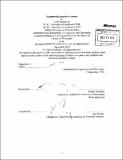Framework theories in science
Author(s)
Henderson, Leah
DownloadFull printable version (8.432Mb)
Other Contributors
Massachusetts Institute of Technology. Dept. of Linguistics and Philosophy.
Advisor
Robert Stalnaker.
Terms of use
Metadata
Show full item recordAbstract
This thesis consists of three papers on the nature of scientific theories and inference. In many cases, scientific theories can be regarded as organized into hierarchies, with higher levels sometimes called 'paradigms', and lower levels encoding more specific or concrete hypotheses. The first chapter uses hierarchical Bayesian models to show that the assessment of higher level theories may proceed by the same Bayesian principles as the assessment of more specific hypotheses. It thus shows how the evaluation of higher level theories can be evidence-driven, despite claims to the contrary by authors such as Kuhn. The chapter also discusses how hierarchical Bayesian models may help to resolve certain issues for Bayesian philosophy of science, particularly how to model the introduction of new theories. The second chapter discusses the relationship between Inference to the Best Explanation (IBE) and Bayesianism. Van Fraassen has raised the concern that the explanatory considerations in IBE go beyond the Bayesian formalism, making IBE incompatible with Bayesianism. The response so far has been that the explanatory considerations can be accommodated within the Bayesian formalism by stipulating that they should constrain the assignment of the probabilities. I suggest a third alternative, which is that the extra explanatory considerations have their origins in the relationship between higher and lower level theories and can be modeled in Bayesian terms without directly constraining the probabilities. The third chapter discusses an aspect of the debate over scientific realism. The No Miracles argument and the Pessimistic Induction are often seen as the primary arguments for and against scientific realism. Yet recently it has been alleged that both of these arguments commit the base-rate fallacy. I argue that both arguments can be formulated in a non-fallacious manner, so neither should be dismissed on the grounds of faulty form alone.
Description
Thesis (Ph. D.)--Massachusetts Institute of Technology, Dept. of Linguistics and Philosophy, 2010. "September 2010." Cataloged from PDF version of thesis. Includes bibliographical references (p. 127-133).
Date issued
2010Department
Massachusetts Institute of Technology. Department of Linguistics and PhilosophyPublisher
Massachusetts Institute of Technology
Keywords
Linguistics and Philosophy.